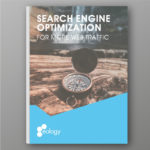Introduction: Why EEAT determines SEO success today
Much is changing in search engine optimization – but one thing is certain: hardly anything works today without EEAT. The Google concept of Experience, Expertise, Authoritativeness and Trustworthiness is not only part of the Google EEAT Guidelines, but has long since become the central benchmark for the evaluation of websites. The EEAT guidelines are particularly crucial for sensitive topics – so-called YMYL content (Your Money or Your Life).
Whether you operate in the fields of health, finance, medicine, law or lifestyle – EEAT has a significant influence on how Google rates your content in the search results. Even if it is not a direct ranking factor in the algorithm, EEAT serves as an evaluation basis for Google’s Quality Evaluators. Their feedback and results are continuously incorporated into algorithm updates. If you ignore the EEAT principle, you will lose your chances of visibility – if you implement our tips, you will strengthen your brand, your trust and your relevance in the digital space.
What is behind the EEAT concept?
EEAT is made up of four interlinked factors that Google uses to evaluate the quality of content. Each aspect has an impact on the ranking and the user’s perception:
1. experience
Google wants to know: Does the author actually have personal experience with the topic? This is particularly important for product reviews, travel reports or tutorials. Content with photos, videos or real case studies appears authentic and increases trustworthiness.
2. expertise (specialist knowledge)
Specialist knowledge is the result of sound training, professional experience and depth of knowledge. Google pays particular attention to medical, legal or financial topics to ensure that the author is qualified. Detailed author profiles, mention of certificates, correct sources and structured content play a central role here.
3. authoritativeness (authority)
Authoritativeness means that the author or website is perceived as a recognized authority. This is achieved through backlinks, mentions in specialist publications, social proof and clear brand management. A high domain authority also has a supporting effect here.
4. trustworthiness (trustworthiness)
Trust is the basis. This includes technical security (HTTPS), transparent imprint and data protection information, a clear presentation of advertising, but also genuine customer reviews. Content must be neutral, correct and comprehensible.
How does EEAT influence Google’s rating?
Even though EEAT is not a direct ranking factor in the EEAT algorithm, it influences the weighting of content by the quality raters – the so-called evaluators. These use the Quality Raters Guidelines to assess websites with regard to their content, their source and their level of usefulness.
The higher the EEAT value, the more likely it is that content will send positive signals to the algorithm – especially for highly competitive keywords or in sensitive areas. Google wants to deliver quality content that matches the search query and the user’s search intent.
EEAT in YMYL areas: Stricter rules for critical topics
YMYL content is particularly sensitive for Google. Why? Incorrect information about health, finances or security can cause real damage. This is why the requirements for specialist knowledge and reliability are particularly high here.
Typical YMYL sectors:
- Medical or psychological advice
- Tax, pension or investment tips
- Legal information (e.g. labor law)
- Nutrition, diets, supplements
- Parents’ guide or safety tips
If you publish in these areas, you should plan, structure and substantiate your content particularly carefully. A high EEAT value acts as a protective shield against ranking losses.
EEAT Best Practices: The best strategies for more trust and ranking
Each article needs a complete author profile with photo, bio, qualifications and – if possible – external links (e.. to LinkedIn, certificates or publications).
2. include references and citations
References to scientific studies, expert opinions or official information strengthen the truthfulness and comprehensibility for visitors to your website.
3. update content regularly
Outdated information looks dubious. A continuous content audit helps to keep content up to date – ideally with a timestamp in the article.
4. promote user-generated content
User reviews, testimonials or forum posts increase the EEAT value and offer new entry points for search intent-based content.
5. clearly position the brand
A uniform appearance across website, social media, author profiles and content ensures consistency and strengthens trust in your brand.
Although there is no official EEAT score, there are various tools and methods for analyzing the impact of your EEAT measures:
- Domain authority (e.g. with Moz or Ahrefs)
- Backlink profile analysis (e.g. with Semrush)
- Length of stay, bounce rate and pages/session (Google Analytics)
- Social proof monitoring (Trustpilot, ProvenExpert, Google reviews)
- Sentiment analysis of brand mentions (e.g. with Brandwatch)
These indicators help you to evaluate the development of your visibility, your trust and your user loyalty – important indicators for your EEAT success.
Common mistakes and how to avoid them
Error | Solution |
|---|
No author named | Always create a complete author profile |
Lack of sources | Relevant, credible sources provide evidence |
Old contents | Update content regularly |
Technically insecure website | Set up HTTPS encryption |
Advertising not labeled | Making sponsored content transparent |
Inconsistent branding | Establish uniform brand communication |
Generic AI texts without control | AI as a basis, but reworked and personalized by humans |
Table 1: Common mistakes EEAT
Bonus: EEAT checklist for companies
✔️ Author profiles with qualifications
✔️ HTTPS certificate active
✔️ Privacy policy and legal notice clearly visible
✔️ Up-to-date, researched content
✔️ References and external links
✔️ Customer reviews integrated
✔️ Brand consistent across all channels
✔️ Expert interviews or guest contributions
✔️ Regular content audits
✔️ Content prepared in the style of the target group
Conclusion: EEAT as the key to sustainable SEO and trust
EEAT is one of the most important keywords in modern SEO today. It stands for quality, trust and credibility – and therefore for everything that Google wants to prioritize in its search results.
Those who create, structure and maintain their content according to the EEAT criteria not only increase their visibility in the search engine, but also sustainably strengthen their brand, user trust and conversion rate.
Especially in critical areas such as medicine, finance or health, optimization according to EEAT is a must. However, the concept also offers companies that are active in less regulated markets the opportunity to stand out from the competition with high-quality content and clear positioning.
FAQ – Frequently asked questions about EEAT
What does EEAT mean?
EEAT stands for Experience, Expertise, Authoritativeness and Trustworthiness – a Google evaluation concept for assessing content quality.
Is EEAT a direct ranking factor?
No, but it indirectly influences the algorithm through the feedback from Google Quality Raters.
What are YMYL topics?
Health, finance, security, law – in other words, all content that can have a significant impact on users’ lives.
How do I measure EEAT?
Indirectly via engagement metrics, domain authority, backlink profile, customer ratings and mentions.
What is the difference between experience and expertise?
Experience is personal experience with the topic, expertise is sound specialist knowledge. The two complement each other perfectly.
Why is trustworthiness so important?
Because trust is the basis of every user decision – and because Google systematically devalues unreliable content.








